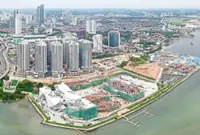GEORGE TOWN: The sea around Penang is being assailed by a red tide: thick streaks of algal blooms in garish, bright pink streaks all around the island.
The good news is that scientists confirmed that this algal bloom is non-toxic and will not kill marine life that comes into contact with it.
The Star journalist Andy Lo, who spent his day off yesterday at Monkey Beach in Teluk Bahang, said he spotted the bright pink streaks about 100m from shore at 11.30am, and by 12.15pm, the red tide landed on the beach.
“It was thick and the bright pink looked so unnatural at sea. You can easily see how the algae clings to each other and formed a long chain that stretched for kilometres.
“Some people at the beach started shouting for everyone to get out of the water, and there was a short moment of panic.
“When the red tide landed on the beach, the waves broke it up and by then, the water by the shore turned dull pinkish red,” he said.
Frightening as it might look, scientists confirm that the algae is Noctiluca scintillans, and it is non-toxic beyond having an ammonia content that might drive some fish away.
Marine biologist Professor Datuk Dr Aileen Tan said a team from Universiti Sains Malaysia’s Centre for Marine and Coastal Studies (Cemacs) took samples of the algae and checked them under a microscope.
“Not all red tides are deadly to marine life. In this case, some copepods (small crustaceans) even feed on the Noctiluca scintillans,” she said as she gave the assurance that it was not harmful to humans, and that fish caught around Penang was still safe to eat.
“It starts with prolonged hot weather, followed by sudden substantial rainfall which sends nutrients pouring into the sea,” she explained, noting that Penang and Kedah did have a few days of heavy evening showers recently, a common occurrence during the inter-monsoon period.
She said local fishermen had called Cemacs scientists since Friday when they spotted the bright pink streaks.
“The first sighting was around Pulau Aman (off the mainland near the second Penang bridge) on Friday. This morning, it was also at Pulau Betong (about 1km from the south of the island),” she said.
Nonetheless, Tan urged policy makers to pay attention because it is a sign of ill conditions at sea.
“If this happens frequently, it is a sign of the ugly side of climate change. The sea gets warmer, more acidic, and holds less oxygen. Algae in thick concentrations will take up all the oxygen at night,” she warned, urging for greater pollution control to reverse the harm.
When red tides are formed by an algae called Margalefidinium polykrikoides, which tend to create a dull, rusty red hue at sea, all marine life and even corals die upon exposure even in low concentrations because of the harmful allelopathic chemicals they produce.
While uncommon around Malaysia, the conditions that trigger harmful algal blooms are the same as those which created the bright pink streaks floating around Penang now.









































